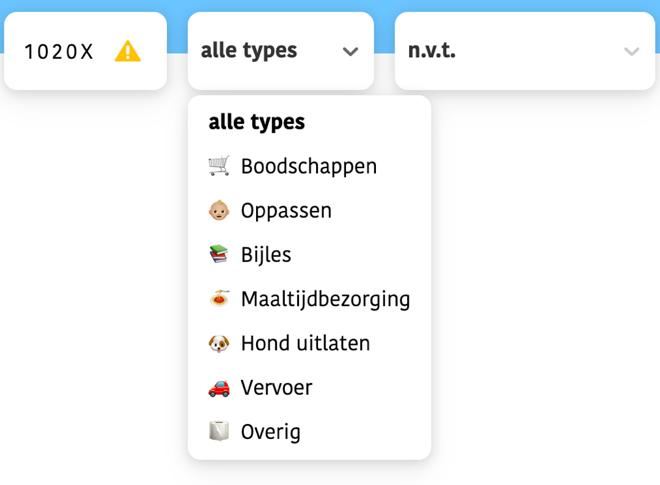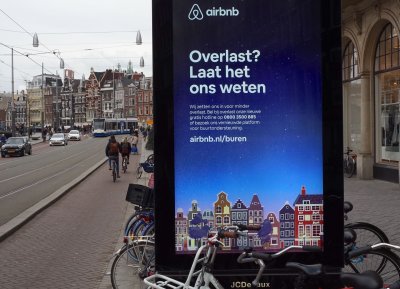The outbreak of Covid-19 in the Netherlands quickly led to an outbreak of (purported) citizen solidarity: many citizens offered their help to practically or socially support vulnerable fellow citizens. In some ways comparable to the response following the refugee influx a few years earlier, Covid-19 stimulated the activation of tens of thousands new potential volunteers who subscribed to humanitarian organizations (such as the Red Cross) and online channels, such as volunteering and neighborhood platforms as well as Facebook groups1. Accordingly, this led to celebrations of the Dutch population as being remarkably civic-minded.
But how can we situate this citizen support (and the enthusiasm guiding it) within a broader socio-political context? And how can we relate it to the rise and role of digital platforms operating in the area of citizen-based welfare? This blog post will zoom in, first, on the political paradigm guiding the celebration and facilitation of volunteering, both in general and in specific relation to Covid-19. Second, the blog post discusses the particular role of what I call post-welfare platforms, questioning how these platforms (re)organize and redefine solidarity as a matchmaking process.
Individual responsibility for the common good
For some, the outbreak of Covid-19 and the responses it evoked can be conceptualized as a state of exception. In contrast, I propose here to perceive it as an acceleration of socio-political processes that were hitherto more latently present, and that might sustain in post-corona times: namely a political belief in self-organization and a reliance on volunteering capacity. Anthropologist Andrea Muehlebach already noticed that current welfare state transformations are characterized by shifting the reproduction of solidarity and social reproduction more generally onto an active and 'dutiful' citizenry. In other words: individuals are deemed responsible for the reproduction of solidarity and the common good. In her book, she writes that "solidarity is outsourced onto citizens [..] every one of which is now coresponsible for the public good" (p. 12). This is accompanied with the mobilization of "sources of cheap labor and unpaid domestic and volunteer work" (p. 11).
An indication of this reliance on volunteers arose when Dutch prime minister Mark Rutte publicly thanked all volunteers for their effort during a video call addressing corona volunteering. He tweeted: "Gratitude to all organizations and volunteers who are committed to someone else day in day out. This is the only way through which we, as the Dutch all together, can get through this crisis" (see image 1).

Image 1: Dutch prime minister Mark Rutte publicly thanks corona volunteers
In streamlining the current surge of volunteer potential, it is both governments and private platform enterprises that play a facilitating role. Before highlighting the role of private platforms in the next section, I discuss here two policy responses the local municipality of Amsterdam launched to technically and financially support civic initiatives. The first of these also concerned the development of a digital platform.
A few weeks after the Covid-19 outbreak, the municipality of Amsterdam launched its own digital corona platform displaying all (offline and online) civic corona initiatives. This platform, titled We Amsterdam - notice the slight twist of the city's well-known slogan I Amsterdam - currently counts 426 local initiatives. On the platform, the municipality describes its role as "strengthening all beautiful initiatives that are currently coming into existence" and as raising the visibility and searchability of these initiatives. It is expressed that "We Amsterdam takes care of additional publicity of your work. This way you can focus on the beautiful work you do. And We Amsterdam ensures that you're findable for everyone that needs it". In particular the aim is that citizens "with beautiful initiatives", citizens "that like to contribute" and citizens "that are looking for support" can find each other on the platform.
As a second policy measure, the government of Amsterdam recently installed an accelerated procedure for subsidies to citizen initiatives, aiming at those "which are an addition or improvement to the existing supply of physical [..] or social facilities".
Both responses are characteristic of an underlying policy rationale that is increasingly common: when governments deliver the infrastructure, the rest will solve itself. This has been called, among other things, 'reinvented government', 'entrepreneurial government or 'government as a platform'. According to this perspective, governments are defined as enabler and expected to 'steer rather than row'. By providing an infrastructure on which external parties can build tools, governments would raise the potential for innovation, participation and experimentation. As the state provides basic arrangements, it enables the private sector -- being it enterprises or citizens - to flourish.
Platforms and the (re)organization of solidarity
In combination with local governments providing an underlying technical or financial infrastructure for citizen-based welfare, the corona outbreak also led to the rapid proliferation of privately operating volunteering and neighborhood platforms. What, then, is the role of these private platforms in the reorganization and redefinition of solidarity during the corona pandemic2?
As mentioned above, the Covid-19 outbreak led to a surge of potential volunteers looking for a way to help. This brings to mind what Dutch sociologist Evelien Tonkens defined as altruistic surplus, referring to citizens' (latent) willingness to engage in volunteering activities, which becomes suddenly visible when an opportunity arises for them to make themselves useful. Importantly, however, this surplus is not a particularly 'targeted' or 'directed' surplus, but is rather characterized by citizens and organizations that -- in the words of a platform developer - "want to do something but they don't know what or how".
It is precisely in response to this dilemma that platforms appear as crucial entry points and amplifiers of volunteering potential. As one platform operator expressed: for many of these motivated but undirected citizens, digital volunteering platforms provide a first entry point into exploring the provision of social support. With the help of search engine optimization, these platforms appear on top of the search results when browsing the web for 'volunteering' or 'corona support'. Furthermore, they regularly provide an easy sign-on option through a user's Facebook or Google account.
Relatedly, platform operators perceive it as one of their key challenges to achieve an accessible and 'low-key' platform. Effort is put in simplifying the user experience (UX) design of the platform, with the expectation that this will lower the threshold for prospective users who seek to offer or request help. For example, these platforms provide tools to automatically funnel the supply of and the demand for help, by guiding users through standardized templates and options. People can choose for particular categories of support, such as doing groceries, dog walking or babysitting (see image 2). Users can also choose a particular duration (e.g. once only, occasionally, regularly). Furthermore, they are regularly restricted to a maximum word count -- for example 160 or 600 signs -- and are sometimes explicitly encouraged to keep their message 'short and clear'.

Image 2: selecting categories of support
Platforms as matchmakers?
How, then, does this socio-technical format of the platform relate to Tonkens' notion of altruistic surplus? On the one hand, these platforms provide a clear and attractive format that stimulates users to subscribe to the platform and potentially become a volunteer. On the other, it also stimulates users to offer more or less the same kind of help, leading to a standardization of possible forms of "solidarity". As one platform developer noticed, doing groceries is by far the most offered type of support.
The dynamics on these platforms thus tend to translate altruistic surplus into a demarcated, easily provided type of support, rather than fostering the kind of support that is long-term, complex, and/or time and labor intensive. What emerges is a pool of flexible or occasional volunteers ('flexiteering'), which hints at a form of conditional altruism. Platforms do not only respond to the current trend of short-term and flexible volunteering, but also enable and promote it through their interface and design.
In general, most of these platforms seem particularly suited and designed for attracting volunteers, but less preoccupied with including citizens in need of help. While platforms focus much of their attention on the facilitation of technically low-key features, this neglects the fact that vulnerable populations may (socially) experience "high-key" obstacles, such as people who lack (digital) literacy or in other ways face social exclusion. In defining social problems as solvable by technical solutions, this foregoes the observation made by sociologist Lilian Linders that these thresholds for requesting or providing help may be mental and social rather than predominantly technical. More fundamentally, it risks defining solutions to social problems and social reproduction as a match-making issue, rather than addressing and dealing with underlying questions or inequalities.
Conclusion
The Covid-19 outbreak shows the ongoing relevance of what Muehlebach defined as ethical citizenship, in which citizens are imagined as bound together by moral and affective ties. This accordingly feeds a political ideal in which (dutiful) individuals become responsible for the reproduction of solidarity and the public good. Digital platforms are congenial to this definition of social policy, offering an infrastructure to quickly scale and accommodate citizen-based solidarity initiatives and desires. While private platform operators already had an infrastructure in place prior to Covid-19, the local government of Amsterdam also responded with the launch of a digital platform. What these platforms have in common is that they are equally trying to link initiatives, active and dutiful citizens, and those in need for help.
While platforms do play a crucial role in the mobilization and processing of volunteers and voluntary acts, they risk producing what we may call a logistical imagination of solidarity, in which solidarity is primarily about bringing supply and demand together. It risks foregoing underlying and more structural questions, or, as one platform provider expressed it, 'the question behind the question'. Both the platform launched by the municipality of Amsterdam and the private platforms emphasize visibility, findability, and the potential of networks: when people are brought together (and the underlying infrastructure is provided), this will lead to innovation, social solutions and participation.
However, this vision is particularly directed at (and suited for) potential volunteers, and less engaged with finding and including citizens in need of help, nor addressing more structural social problems and inequalities. When solidarity becomes an affair organized through match- and market-based charitable acts, some groups risk falling through the cracks.
Notes
-
The Dutch 'Ready2help' (Red Cross) citizen-assistance network currently counts over 85.000 members. A newly launched corona platform raised 40.000 subscriptions. ↩
-
Examples of these private platforms are volunteering platforms NLvoorElkaar, Deedmob, Wehelpen and Gewoonmensendiewillenhelpen and neigborhood platforms Mijnbuurtje and Voorjebuurt. In reality, the boundary between 'public' and 'private' is rather blurred, as many of these platforms regularly contract with local governments to help facilitate local social cohesion and citizen engagement. ↩


